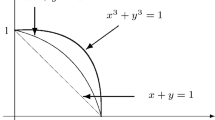Abstract
The concepts of Q-effective solution and effective solution are extended to the model of multi-objective linear programming problem with fuzzy coefficients in constraints. Q-effective solution and effective solution are defined as fuzzy sets. The degree of an element as Q-effective solution is uniquely determined, and it fully describes the degree of solution satisfying constraints. Further, the concept of effective solution is introduced. Finally, a numerical example is given to illustrate the difference between Q-effective solution and effective solution.
Similar content being viewed by others
References
Tian Z, Hu L (2008) The structure of solution space in fuzzy linear programming problem. Basic Sci J Textile Univ 21:161–166
Abo-Sinna MA, Amer AH, Ibrahim AS (2008) Hierarchical generation of α-Pareto optimal solutions in large-scale multi-objective non-linear systems with fuzzy parameters. Appl Math Model 32:930–957
Zhao R, Hao S (2010) Modeling and solving a novel class of fuzzy constraint satisfaction problems. J Syst Eng 25:415–420
Baykasoglu A, Gocken T (2010) Multi-objective aggregate production planning with fuzzy parameters. Adv Eng Softw 41:1124–1131
Jimenez M, Bilbao A (2009) Pareto-optimal solutions in fuzzy multi-objective linear programming. Fuzzy Sets Syst 160:2714–2721
Baky IA (2010) Solving multi-level multi-objective linear programming problem through fuzzy goal programming approach. Appl Math Model 34:2377–2387
Ozkok BA, Tiryaki F (2011) A compensatory fuzzy approach to multi-objective linear supplier selection problem with multiple-item. Expert Syst Appl 38:11363–11368
Amid A, Ghodsypour SH, O’Brien C (2011) A weighted max-min model for fuzzy multi-objective supplier selection in a supply chain. Int J Prod Econom 131:139–145
Wu W, Lin YT (2010) Fuzzy-based multi-objective optimization of DMFC system efficiencies. Int J Hydrogen Energy 35:9701–9708
Yu M, Goh M, Lin H (2012) Fuzzy multi-objective vendor selection under lean procurement. Eur J Oper Res 219:305–311
Sakawa Masatoshi, Katagiri Hideki, Matsui Takeshi (2012) Fuzzy random bilevel linear programming through expectation optimization using possibility and necessity. Int J Mach Learn Cybern 3(3):183–192
Sakawa M, Matsui T (2012) Random fuzzy bilevel linear programming through possibility-based fractile model. Int J Mach Learn Cybern. doi:10.1007/s13042-012-0145-1
Katagiri H, Uno T, Kato K, Tsuda H, Tsubaki H (2012) Random fuzzy bilevel linear programming through possibility-based value at risk model. Int J Mach Learn Cybern. doi:10.1007/s13042-012-0126-4
Sakawa M, Yano H (1989) Interactive decision making for multi-objective nonlinear programming problems with fuzzy parameters. Fuzzy Sets Syst 29:315–326
Sakawa M, Yano H (1990) An interactive fuzzy satisfying method for generalized multi-objective linear programming problems with fuzzy parameters. Fuzzy Sets Syst 35:125–142
Kassem M (1995) Interactive stability of multi-objective nonlinear programming problems with fuzzy parameters in the constrains. Fuzzy Sets Syst 73:235–243
Kassem M (1995) Stability of multi-objective nonlinear programming problems with fuzzy parameters in the constrains. Fuzzy Sets Syst 74:43–351
Gu J, Zhou R (2002) Multi-objective programming problem with fuzzy parameter in constrains (I)-the definition and property of solution. Nanchang Univ J 26:151–157
Gu J, Zhou R (2003) Multi-objective programming problem with fuzzy parameter in constrains (II)-the properties of constrains and image set. Nanchang Univ J 27:8–13
Gu J, Zhou R (2002) Multi-objective programming problem with fuzzy parameter in constrains (III)-the existence of solution. Nanchang Univ J 15:88–91
Acknowledgments
This work is supported by the Natural Science Foundation of Hebei Province under Grand A2012502061.
Author information
Authors and Affiliations
Corresponding author
Rights and permissions
About this article
Cite this article
Zhang, G., Zuo, H. Research on multi-objective linear programming problem with fuzzy coefficients in constraints. Int. J. Mach. Learn. & Cyber. 5, 403–412 (2014). https://doi.org/10.1007/s13042-013-0173-5
Received:
Accepted:
Published:
Issue Date:
DOI: https://doi.org/10.1007/s13042-013-0173-5




